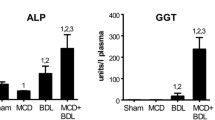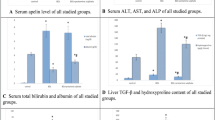Abstract
Background The effect of selective bile duct obstruction (SBDO) on hepatic reserve function of the bile duct obstructed (BDO) and nonobstructed freely draining (FD) lobes of the liver is obscure. Methods The bile duct branches draining from the left lateral and median lobes of the liver were ligated for 4 and 10 days in rats, and hepatic reserve functions in BDO and FD lobes were assessed by microsomal cholesterol 7α-hydroxylase activities and by hepatic adenine nucleotide and energy charge levels. The values were com-pared with those in sham-operated control liver. Cholesterol 7α-hydroxylase activities were determined by gas-liquid chromatography-mass spectrometry, and hepatic adenosine triphosphate (ATP), adenosine diphosphate (ADP), and adenosine monophosphate (AMP) levels with high-pressure liquid chromatography. Results The histological examination of the BDO lobes showed proliferation and formation of new bile ductules and fibrous connective tissue linking portal areas. Microsomal cholesterol 7α-hydroxylase activities, hepatic energy charge and adenine nucleotide levels did not differ between FD and BDO lobes, and the values were similar to those in the sham-operated liver. Conclusions Selective bile duct obstruction shows no adverse effects on microsomal and mitochondrial functions in either BDO or FD lobes of the liver.
Similar content being viewed by others
References
Accantino L, Contreras A, Fernandez S, Quintana C (1979) The effect of complete biliary obstruction on bile flow and bile acid excretion: postcholestatic choleresis in the rat. J Lab Clin Med 93:706–717
Alpini G, Lenzi R, Sarkozi L, Tavoloni N (1988) Biliary physiology in rats with bile ductular cell hyperplasia: evidence for a secretory function of proliferated bile ductules. J Clin Invest 81:569–578
Slott PA, Liu MH, Tavoloni N (1990) Origin, pattern and mechanism of bile duct proliferation following biliary obstruction in the rat. Gastroenterology 99:466–477
Tanaka J, Ozawa K, Tobe T (1979) Significance of blood ketone body ratio as an indicator of hepatic cellular energy status in jaundiced rabbits. Gastroenterology 76:691–697
Komura M, Chijiiwa K, Naito T, Kameoka N, Yamashita H, Yamaguchi K, Kuroki S, Tanaka M (1996) Sequential changes of energy charge, lipoperoxide level and DNA synthesis rate of the liver following biliary obstruction in rats. J Surg Res 61:503–508
Hadjis NS, Blenkharn JI, Hatzis G, Adam A, Beacham J, Blumgart LH (1990) Patterns of serum alkaline phosphatase activity in unilateral hepatic duct obstruction: a clinical and experimental study. Surgery 107:193–200
Ozawa K, Tanaka J, Ukugusa M, Kimura K, Tobe T (1979) Early metabolic disturbances in the liver following unilateral hepatic or common bile duct obstruction in rabbits. Eur Surg Res 11:61
Kanai M, Tanaka M, Nimura Y, Nagino M, Katoh T, Ozawa T (1992) Mitochondrial dysfunction in the non-obstructed lobe of rat liver after selective biliary obstruction. Hepatogastroenterology 39:385–391
Adler RD, Wannagat FJ, Ockner RK (1977) Bile secretion in selective biliary obstruction. Adaptation of taurocholate transport maximum to increased secretory load in the rat. Gastroenterology 73:129–136
Bellentani S, Ferrari A, Villa E, Manenti F (1981) Study of the long-term effects of selective biliary obstruction (SBO). Res Exp Med 178:229–235
Cooper AD, Jones AL, Koldinger RE, Ockner K (1974) Selective biliary obstruction: a model for the study of lipid metabolism in cholestasis. Gastroenterology 66:574–585
Ozawa K, Aoyama H, Yasuda K (1983) Metabolic abnormalities associated with post-operative organ failure. Arch Surg 118:1245–1251
Chijiiwa K, Kameoka N, Saeki S, Komura M, Yamaguchi K, Kuroki S, Tanaka M (1996) Functional contribution of preoperative portal vein occlusion to hepatectomy: with special reference to hepatic energy charge and DNA synthesis after hepatectomy in rats. Arch Surg 131:779–784
Kameoka N, Chijiiwa K, Kozaki N, Makino I, Naito T, Tanaka M (1996) Hepatic adenine nucleotides and DNA synthesis during the regenerative and atrophic process of the liver lobes after selective portal vein ligation. Eur Surg Res 28:212–221
Okamoto S, Fukushima K, Higashijima H, Makino I, Kishinaka M, Oda H, Yamashita H, Ichimiya H, Chijiiwa K, Kuroki S (1994) Serum 7α-hydroxycholesterol reflects hepatic bile acid synthesis in patients with obstructive jaundice after external biliary drainage. Hepatology 20:95–100
Kuroki S, Okamoto S, Naito T, Oda H, Nagasa S, Sakai S, Nawata H, Yamashita H, Chijiiwa K, Tanaka M (1995) Serum 7α-hydroxycholesterol as a new parameter of liver function in patients with chronic liver diseases. Hepatology 22:1182–1187
Polimeno L, Azzarone A, Zeng QH, Panella C, Subbotin V, Carr B, Bouzahzah B, Francavilla A, Starzl TE (1995) Cell proliferation and oncogene expression after bile duct ligation in the rat: evidence of a specific growth effect on bile duct cells. Hepatology 21:1070–1078
Mashige F, Imai K, Osuga T (1976) A simple and sensitive assay of total serum bile acid. Clin Chim Acta 70:79–86
Yamashita H, Kuroki S, Nakayama F (1990) An assay of cholesterol 7α-hydroxylase utilizing silica cartridge column and 5α-cholestane-3β,7β-diol as internal standard. J Chromatogr 496:255–268
Reihner E, Angelin B, Rudling M, Ewerth S, Bjorkhem I, Einarsson K (1990) Regulation of hepatic cholesterol metabolism in humans: stimulatory effects of cholestyramine on HMG-CoA reductase activity and low density lipoprotein receptor expression in gallstone patients. J Lipid Res 31:2219–2226
Lowry OH, Rosebrough NJ, Farr AL, Randall RJ (1951) Protein measurement with the Folin phenol reagent. J Biol Chem 193:265–275
Kamiike W, Burdelski M, Steinhoff G, Ringe B, Lauchart W, Pichlmayr R (1988) Adenine nucleotide metabolism and its relation to organ viability in human liver transplantation. Transplantation 45:138–143
Atkinson DE (1970) Enzymes as control elements in metabolic regulation. In: Boyer PD (ed) The enzymes, vol 1. Academic Press, New York, pp 461–489
Ni Y, Lukito G, Marchal G, Cresens E, Yu J, Petre C, Baert AL, Fevery J (1994) Potential role of bile duct collaterals in the recovery of the biliary obstruction: experimental study in rats using microcholangiography, histology, serology and magnetic resonance imaging. Hepatology 20:1557–1566
Yamamoto K, Fisher M, Phillips J (1985) Hilar biliary plexus in human liver: a comparative study of the intrahepatic bile ducts in man and animals. Lab Invest 52:103–106
Ishida F, Terada T, Nakanuma Y (1989) Histologic and scanning electron microscopic observations of intrahepatic peribiliary glands in normal human livers. Lab Invest 60:260–265
Ove P, Takai S, Umeda T (1967) Adenosine triphosphate in liver after partial hepatectomy and acute stress. J Biol Chem 343:4963–4971
Atkinson DE (1968) The energy charge of the adenylate pool as a regulatory parameter. Interaction with feedback modifiers. Biochemistry 7:4030–4034
Author information
Authors and Affiliations
Rights and permissions
About this article
Cite this article
Chijiiwa, K., Hachiya, Y., Watanabe, M. et al. Hepatic adenine nucleotides and microsomal cholesterol 7α-hydroxylase activity in the obstructed and freely draining lobes of the liver after selective bile duct obstruction. Res. Exp. Med. 197, 13–22 (1997). https://doi.org/10.1007/s004330050051
Received:
Accepted:
Published:
Issue Date:
DOI: https://doi.org/10.1007/s004330050051




